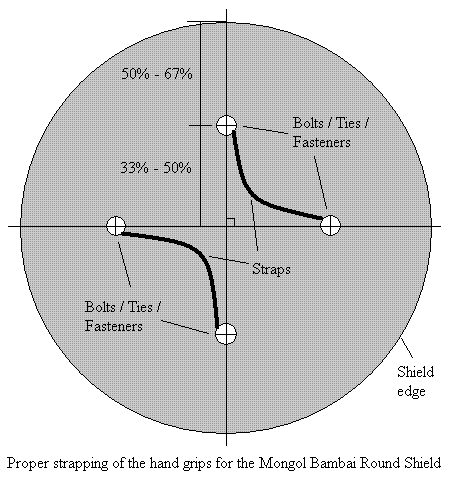
Traditionally, Mongol soldiers in the early days of the Mongol Empire would have used shields constructed out of wicker, probably using willow or rattan, wound into a slightly domed spiral. This would then be covered in leather. similar designs were used across much of Asia including by the Chinese and Tibetans. Extant examples include flat and deeply domed designs. As resources permitted, these shields would be augmented by iron reinforcements and, in later periods, would have been constructed of iron. The straps were made of leather, tied onto the wicker directly, and positioned so that both straps would fit in the fist but be taught enough to offer fine control by turning the wrist.
For use in historical armored combat reenactments such as SCA "Heavy Weapons", I started with a dished out round shield blank available from armorers who merchant at such events. I then bolted leather straps for the hand grip on four symmetrical points that are between 1/3 and half of the radius of the shield from the center. I adjusted the straps so that they remained almost an inch apart when held together in my grip.

This may seem like a difficult and unusual style for using a shield, and it is by our modern standards, so it would help to put this into a historical context before going into the use of the Bambai shield.
The first stop is to observe this design from some historical pictures. The first picture is an illustration by contemporary historian Rashid al-Din who was an administrator in the Mongol Empire. The second, a later period work which is probably Mogul dynasty showing how this style was adapted to metal shields. Note both these pictures show exactly how these shields are held.
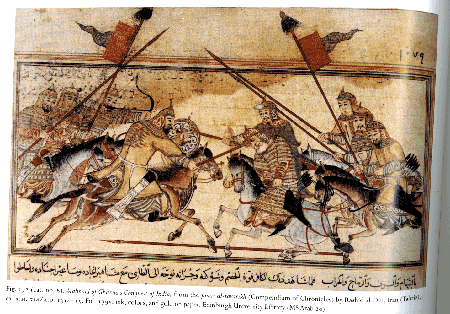
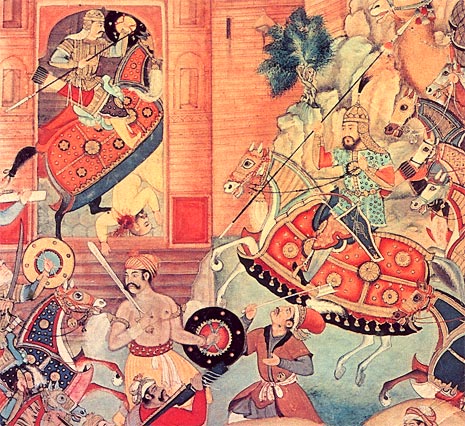
The next important source to look at are extant examples. Following is a Tibetan version from a recent exhibit at The Met. Note that the leather ties indicate that they cannot be criss crossed as one end is looped and the other end tied.
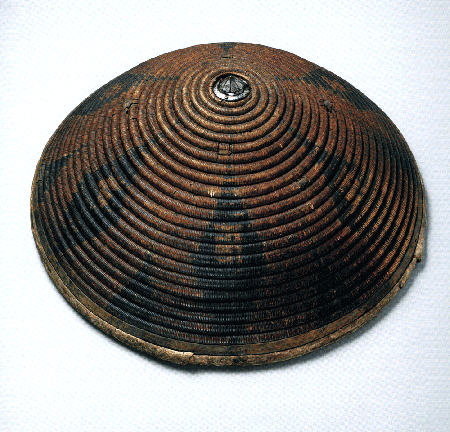
The Chinese were known to arm their cavalry in the nomad fashion, even keeping a seperate form for the cavalry than what was used for foot soldiers. From the Warring States period through the Tang dynasty, mounted archers used a different archery technique (learned from their nomad neighbors) than what was used by foot archers. A similar distinction existed between the shields of a foot soldier and the cavalry. While the round wicker shield was employed by both, the foot soldiers utilized the arm strap while the cavalry used the Mongol style as shown in this Han manual.
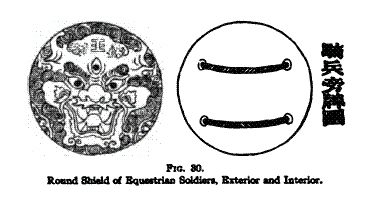
Even with such evidence of how the shield is constructed, the technique for using the shield had to be reconstructed as these have not been in use by soldiers for some time. The first clues came from the historical pictures. Not only did they show that it was held in the hand, but some pictures also showed specific blocks that imply how the shield is held exactly.
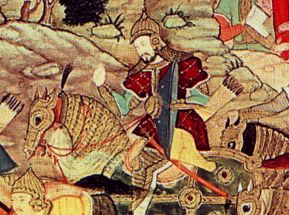
To hold the shield perpendicular to the forearm as pictured here and some other places, the shield must be positioned so that it lay flat against the chest of the fist, the same side your average boxer would punch with.
This also leads to an interesting problem for a person attempting this technique for the first time, it's really hard and tiring. So why would the Mongols, an extremely practical and efficient people, use such a style? Well, the remaining clues arise from both what is known about the Mongol soldiers of the 13th century, and from existing Mongol martial arts still practiced.
Mongol soldiers were all raised as nomads, hunters, and herders. It is an extremely rugged and harsh lifestyle. This has the effect of producing naturally strong people with high endurance. The lifestyle alone of the steppe nomads was the equivelent of the full time training of a modern soldier or professional athlete. Records of Mongol battles include using their higher endurance to outpace their enemies in feigned retreats or endless skirmishes so they could start the main fight when their opponents were tired out but they themselves were not.
Modern Mongols continue to practice some of their age old martial arts including archery and wrestling. The connection with wrestling is obvious and some of the grips used to reach over and around an opponent to grasp his belt and throw him translate quite well into methods of blocking all sorts of offside attacks. Not to be overlooked though is archery. Mongols regard archery as a method of developing skill and focus, much as anywhere else, but it is important to note that Mongols use strong bows and the exact technique for holding a bow works well as a way of holding the shield.
These are skills every Mongol would know. From the endurance of the nomadic lifestyle and the strength and techniques from wrestling and archery, the average Mongolian nomad already possesses the underlying skills necessary to use the Bambai shield. The average Mongol had the strength and endurance necessary to use such a style effectively.
One thing I personally added to the style, not being raised a steppe nomad or having ever witnessed the shield use in battle, was some knowledge of Kung Fu that applied well. Having the grip, guards, and some understanding of the extant of blocking range and angles, the only thing missing was the movement of the blocks. For this I turned to a Wing Chun method of practice known as "Sticky Hands" which entails a softer block of absorbing the force of the blow rather than a static block. Emphasis on the lateral and diagonal directions, following a semicircle around the torso, felt comfortable even when tested on horseback. This connected the guards depicted in period illustrations with the blocks possible from existing Mongol martial arts quite smoothly.
How the shield is held should be clearly understood. It would be incorrect to assume it is held against the back of the fist as if it was strapped to the forearm. Rather, the Mongol Bambai shield would be held against the chest of the fist as shown by the following top view.
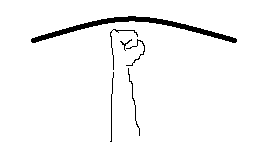
Both straps would be held together in the fist, but adjusted to be tight enought to not touch each other. Unlike a Viking center grip, the two seperate straps allow the wielder to retain fine rotational control over the shield at all times.
An important component of using a shield is to understand some of the basic guards that are effective with your chosen style. Several guards and blocks are apparent when studying some period pictures such as the Rashid al-Din picture on this book cover.
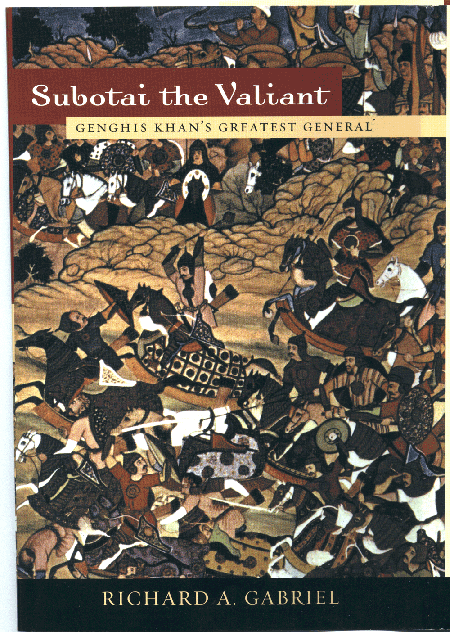
Most obvious, at the middle left, is a guard where the shield is held flat and forward. Here it is raised high to defend against an opponent's strike. This was perhaps the most common and useful guard because of its effectiveness against arrow fire. In hand to hand combat it also has the advantage of keeping your opponent at a distance or being aggressive against the opponent's weapon. This guard also shows the necessity of holding the shield against the chest of the fist.
Below that, in the bottom left, is a variation of that guard where the shield is held closer to the body, and the sword comes directly overhead, with the tip dipping in front of the shield without resting on it, in a position many SCAdians would recognize as a "High Guard".
Less obvious under the word "KHAN", is a further variation of high guard where the shield is held lower, perhaps even resting on the thigh, and the sword is held straight up from the shield. This could be effecive against infantry, and the sword style remained in use through WWI. Note how the sword hand is hidden behind the shield allowing the wielder some degree of deception in making an attack. In hand to hand combat, I rest the bottom edge of the shield on my knee, and rest the bottom of my sword on the top edge of the shield. All SCA legal target areas are covered with minimal effort. I call it my lazy guard and use it to go totally defensive and catch my breath during a long tournament. When being aggressive, I drop the sword behind the shield, and even drop the tip to the back. This is uncomfortable to maintain and difficult to swing from, but can be totally conceiled from the opponent untill the sword is in mid swing minizing the opponent's ability to block the attack.
Going back to the original extended guard, there is one more variation that comes up in period illustrations, including the Mogul dynasty one above. Have the arm extended but turn the wrist outward so the shield rests against the outer forearm. The hand position for this is exactly the same as when holding a bow. From here, a multitude of blocking styles familiar to those with forearm strapped shields can be used.
If you are interested in constructing your own shield in period fashion, I have found this site where someone outlines how to build a Chinese foot soldier's shield. The only change needed to the pattern would be the grip so replace the 4 meters of 5mm rattan with leather straps. For use in SCA combat, you may also want to consider using up to double the wrapping band applying it as tightly together as possible.
Tengpai: The Chinese Rattan Shield, by Peter Dekker
http://forum.grtc.org/viewtopic.php?f=15&t=754
© 2006, 2009 by Luigi Kapaj, in the SCA: Gülügjab Tangghudai (Puppy)
Send comments to Puppy@ViaHistoria.com
return to the Silver Horde home page.
